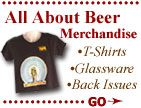
| ||||
| AAB Departments |
| ...Beer Features |
| ...Beer Talk |
| ...Pull Up A Stool! |
| ...What's Brewing |
| ...Beer Travelers |
| ...Stylistically Speaking |
| ...Beer & Food |
| ...Homebrewing |
| ...Collectibles |
| ...Marketplace |
| Beer Lovers' Resources |
| ...World Beer Festival |
| ...Brew Cruise Info |
| ...AAB Merchandise |
| ...AAB Bookstore |
| ...Beer Links |
| About the Magazine |
| ...Subscription Info |
| ...Retail the Magazine |
| ...Wholesaler Program |
| ...Advertising Info |
| ...Contact AAB |

|
Collectables
I've been labeled a collector
A long-time collecting friend and labelologist, Bob Kay has taught me ways to trace brewing history from a simple piece of paper. Most beer bottles contain a neck as well as a body label; some more elaborate packages contain back and shoulder labels or even a foil neck wrap. They are all sources of information, and in the world of beer collectables, we can learn more from the label than from any other source. This small artifact plays an important role in deciphering a brand’s history.
A few clues make it easy to identify labels with a particular period of time. For example, pre-Prohibition labels contained the statement, "Guaranteed Under Food and Drug Act June 30, 1906." When bottling began, the brewery’s name and city were actually embossed onto the bottle. Early paper labels were initially applied over the embossing until the supply of these bottles was depleted.
The most sought-after early labels among collectors are the die cuts. These are labels cut in a way to highlight certain features in the shape of the brand’s logo, a method used by breweries to add some uniqueness or embellishment to a particular beer. Die cuts were more prevalent before Prohibition when labels were applied by hand; modern labeling machines run at a much faster pace when applying a square or oval shape.
Since very few brewers operated their own bottling works, many pre-Prohibition labels listed a separate bottling company as well as the brewery name: for example, "Christian Moerlein Brewing Company, Cincinnati, Ohio, Bottled at the Pittsburgh Branch." The beer was produced in Cincinnati, then sent up river in kegs to Pittsburgh to be packaged in bottles.
Many pre-Prohibition labels resemble the artwork of currency and postage stamps of the time. They contain simple graphics and few colors, which kept the printing cost down. Given the high illiteracy rate among the beer-drinking public, there was very little text.
In fact, some brewers took advantage of the under-educated public by copying the names and graphics of the larger brewers. Beers brewed in New York or Minnesota may have the word Milwaukee, Cincinnati or St. Louis prominently displayed as part of the label design. This was a marketing ploy to fool the under-educated into believing they were drinking a more cosmopolitan brew, as well as an attempt to give the literate consumer confidence in the product.
These borrowed titles also served to define the beer’s style. This was a practice already prevalent in Europe, where many brewers produced münchener (Munich), wiener (Vienna) or bohemian (Pilsen) type beers to define style and capitalize on previous successes.
To slow the prohibition movement, some turn-of-the-century labels promoted beer as a food or health product. Continuing the trend, some brewers in the early years of Prohibition were able to brew beer for medicinal purposes. A prescription was needed to secure your allowance of the golden nectar. Some brewers also produced a hopped malt extract and sold yeast separately.
During Prohibition itself, words like "cereal beverage," "non-intoxicating," "malt beverage" and "tonic" appeared on most of the labels. The wording "manufactured by" instead of "brewed by" also was used. Breweries used names like "products company" or "beverage company," or omitted the words "brewery," "ale" or "beer" from the company’s name altogether.
During World War I, the German heritage of breweries was played down or done away with completely. Various printers’ and brewers’ union labels and symbols often appear as part of labels dating from this era.
Beer Dave Gausepohl has collected breweriana since 1974 and has a personal collection of over 400,000 items. He has visited over 1,000 breweries and tasted well over 10,000 different brews from the world over.








